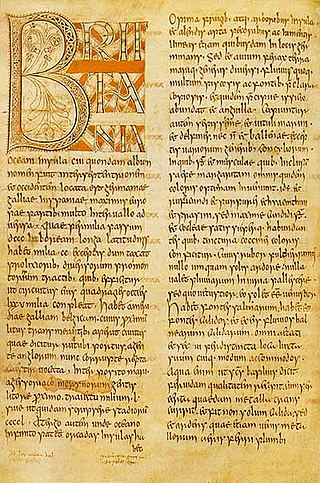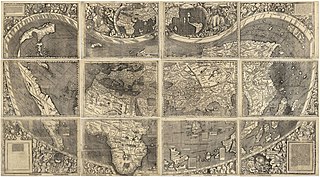
Bede, also known as Saint Bede, the Venerable Bede, and Bede the Venerable, was an English monk and an author and scholar. He was one of the greatest teachers and writers during the Early Middle Ages, and his most famous work, Ecclesiastical History of the English People, gained him the title "The Father of English History". He served at the monastery of St Peter and its companion monastery of St Paul in the Kingdom of Northumbria of the Angles.

The Anglo-Saxons were a cultural group that inhabited much of what is now England in the Early Middle Ages, and spoke Old English. They traced their origins to Germanic settlers who came to Britain from mainland Europe in the 5th century. Although the details are not clear, their cultural identity developed out of the interaction of these settlers with the pre-existing Romano-British culture. Over time, most of the people of what is now southern, central, northern and eastern England came to identify as Anglo-Saxon and speak Old English. Danish and Norman invasions later changed the situation significantly, but their language and political structures are the direct predecessors of the medieval Kingdom of England, and the Middle English language. Although the modern English language owes somewhat less than 26% of its words to Old English, this includes the vast majority of words used in everyday speech.
Bartholomaeus Anglicus, also known as Bartholomew the Englishman and Berthelet, was an early 13th-century Scholastic of Paris, a member of the Franciscan order. He was the author of the compendium De proprietatibus rerum, dated c.1240, an early forerunner of the encyclopedia and a widely cited book in the Middle Ages. Bartholomew also held senior positions within the church and was appointed Bishop of Łuków in what is now Poland, although he was not consecrated to that position.

Cædmon is the earliest English poet whose name is known. A Northumbrian cowherd who cared for the animals at the double monastery of Streonæshalch during the abbacy of St. Hilda, he was originally ignorant of "the art of song" but learned to compose one night in the course of a dream, according to the 8th-century historian Bede. He later became a zealous monk and an accomplished and inspirational Christian poet.

De rerum natura is a first-century BC didactic poem by the Roman poet and philosopher Lucretius with the goal of explaining Epicurean philosophy to a Roman audience. The poem, written in some 7,400 dactylic hexameters, is divided into six untitled books, and explores Epicurean physics through poetic language and metaphors. Namely, Lucretius explores the principles of atomism; the nature of the mind and soul; explanations of sensation and thought; the development of the world and its phenomena; and explains a variety of celestial and terrestrial phenomena. The universe described in the poem operates according to these physical principles, guided by fortuna ("chance"), and not the divine intervention of the traditional Roman deities.

Bernardino Telesio was an Italian philosopher and natural scientist. While his natural theories were later disproven, his emphasis on observation made him the "first of the moderns" who eventually developed the scientific method.

A mappa mundi is any medieval European map of the world. Such maps range in size and complexity from simple schematic maps 25 millimetres or less across to elaborate wall maps, the largest of which to survive to modern times, the Ebstorf map, was around 3.5 m in diameter. The term derives from the Medieval Latin words mappa and mundus (world).
Nothing comes from nothing is a philosophical dictum first argued by Parmenides. It is associated with ancient Greek cosmology, such as is presented not just in the works of Homer and Hesiod, but also in virtually every internal system: there is no break in-between a world that did not exist and one that did, since it could not be created ex nihilo in the first place.
Hicetas was a Greek philosopher of the Pythagorean School. He was born in Syracuse, Magna Graecia. Like his fellow Pythagorean Ecphantus and the Academic Heraclides Ponticus, he believed that the daily movement of permanent stars was caused by the rotation of the Earth around its axis. When Copernicus referred to Nicetus Syracusanus in De revolutionibus orbium coelestium as having been cited by Cicero as an ancient who also argued that the Earth moved, it is believed that he was actually referring to Hicetas.

The Ecclesiastical History of the English People, written by Bede in about AD 731, is a history of the Christian Churches in England, and of England generally; its main focus is on the conflict between the pre-Schism Roman Rite and Celtic Christianity. It was composed in Latin, and is believed to have been completed in 731 when Bede was approximately 59 years old. It is considered one of the most important original references on Anglo-Saxon history, and has played a key role in the development of an English national identity.

Caelus or Coelus was a primordial god of the sky in Roman mythology and theology, iconography, and literature. The deity's name usually appears in masculine grammatical form when he is conceived of as a male generative force.

A T and O map or O–T or T–O map, also known as an Isidoran map, is a type of early world map that represents world geography as first described by the 7th-century scholar Isidore of Seville (c. 560–636) in his De Natura Rerum and later his Etymologiae (c. 625)

Mother Nature is a personification of nature that focuses on the life-giving and nurturing aspects of nature by embodying it, in the form of a mother or mother goddess.

The Waldseemüller map or Universalis Cosmographia is a printed wall map of the world by German cartographer Martin Waldseemüller, originally published in April 1507. It is known as the first map to use the name "America". The name America is placed on South America on the main map. As explained in Cosmographiae Introductio, the name was bestowed in honor of the Italian Amerigo Vespucci.
The Reckoning of Time is an English era treatise written in Medieval Latin by the Northumbrian monk Bede in 725.

Theatrum Chemicum is a compendium of early alchemical writings published in six volumes over the course of six decades. The first three volumes were published in 1602, while the final sixth volume was published in its entirety in 1661. Theatrum Chemicum remains the most comprehensive collective work on the subject of alchemy ever published in the Western world.

Cædmon's Hymn is a short Old English poem attributed to Cædmon, a supposedly illiterate and unmusical cow-herder who was, according to the Northumbrian monk Bede, miraculously empowered to sing in honour of God the Creator. The poem is Cædmon's only known composition.
The Fifteen Signs before Doomsday is a list, popular in the Middle Ages because of millenarianism, of the events that are supposed to occur in the fortnight before the end of the world. It may find an origin in the apocryphal Apocalypse of Thomas and is found in many post-millennial manuscripts in Latin and in the vernacular. References to it occur in a great multitude and variety of literary works, and via the Cursor Mundi it may have found its way even into the early modern period, in the works of William Shakespeare.

Prophetiae Sibyllarum are a series of twelve motets by the Franco-Flemish composer Orlande de Lassus. The works are known for their extremely chromatic idiom.














